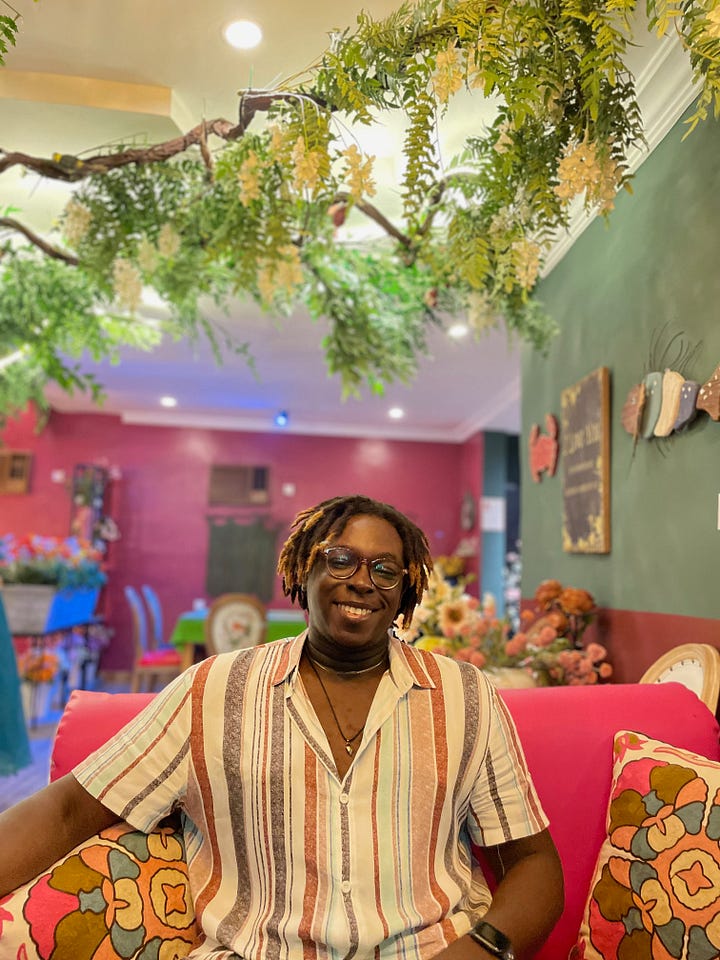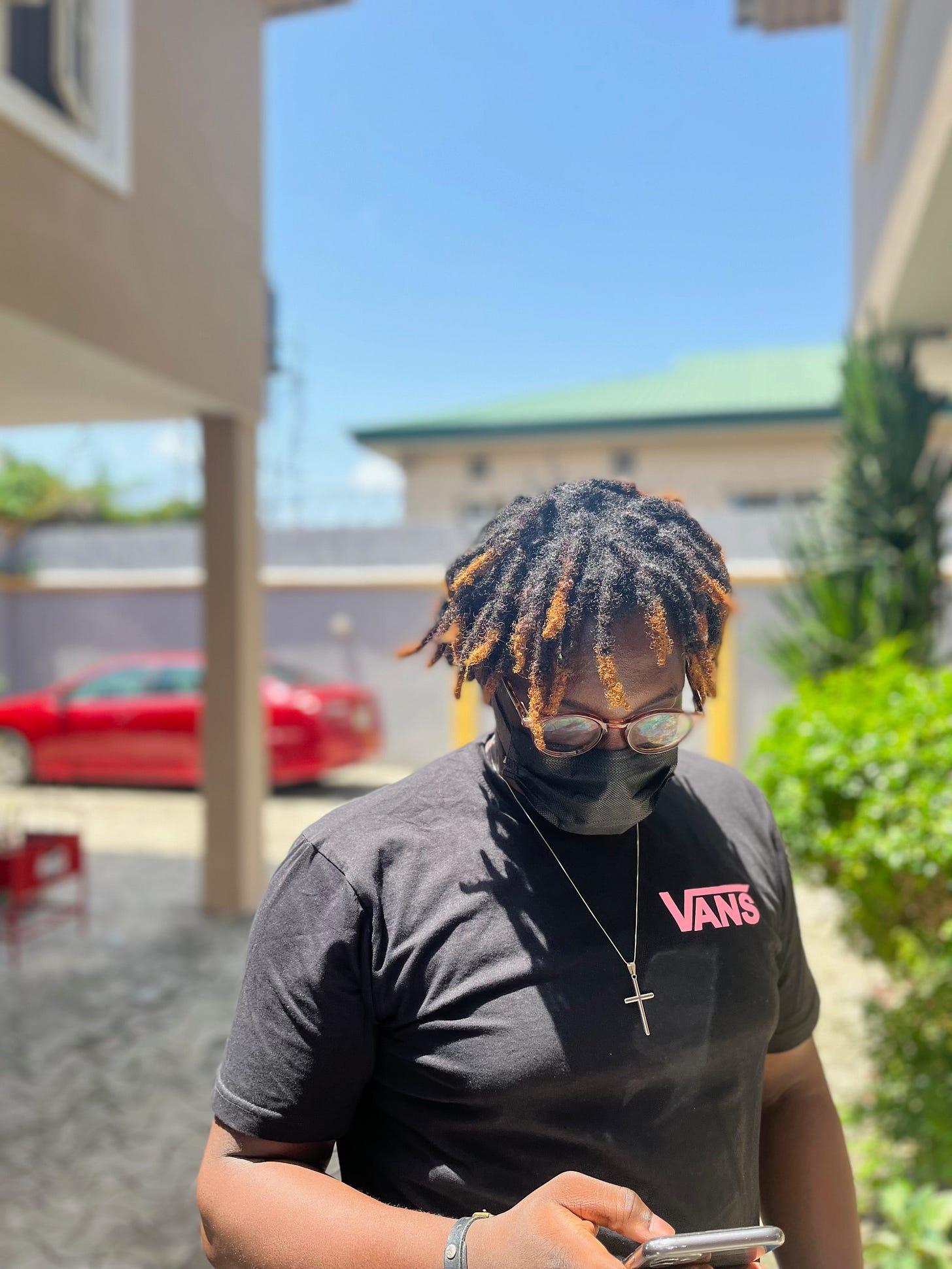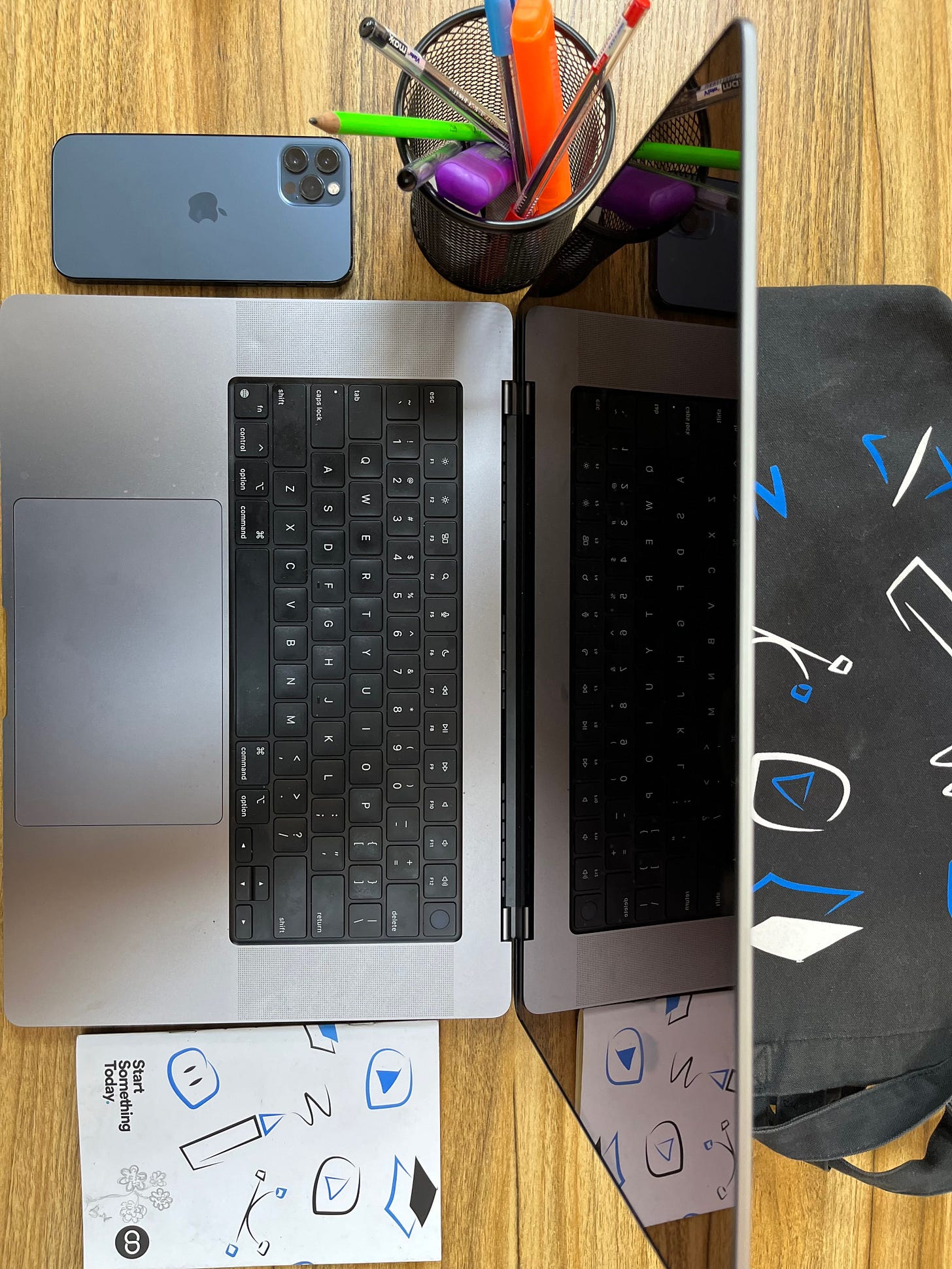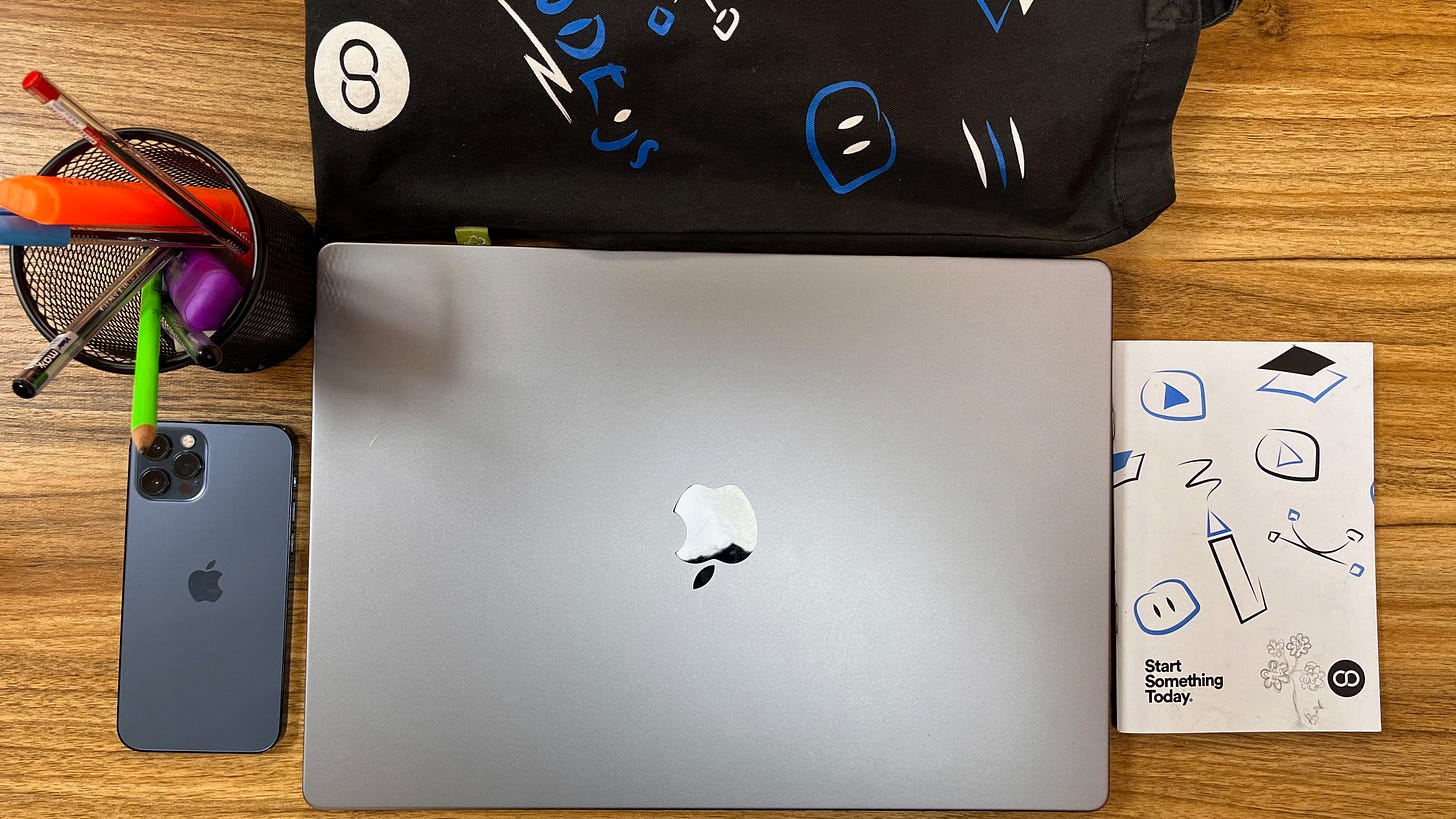Godwin Olatunde: The motion design lead creating magic and sparking joy in people for brands — #007
I transitioned from graphic design to brand design and now motion design... I dabbled in marketing and saw design as a means to get into marketing because I have always loved experiential marketing
Hi, thank you for joining us for another edition of our interview with African Creatives. In this edition, I spoke with Godwin Olatunde, the motion design lead at one of Africa’s leading digital transformation agencies. He shares what led him to design and how he transitioned from graphic design to brand design and now motion design.
If you are curious to know what drives the work he does, the major challenges he faces and how he navigates them, his favourite projects, how he spends his day, the people that inspire him, and the people and brands he would love to work with, you should continue reading. You will definitely love and enjoy reading this!
Tell us about yourself.
My name is Godwin Olatunde. I am currently the motion design lead at Check DC, a digital transformation agency that is focused on creating web and brand experiences for startups and large organizations. I have been at Check DC for 5 years now and I got into Check DC straight out of Uni.
I transitioned from graphic design to brand design and now motion design. My design journey has mostly been at Check DC except for contract works here and there and a brief position at Kuda as the Motion lead for the past year.
Aside from design, I dabble in a lot of things. I am not the greatest music person but I have a certificate in sound engineering and music production. I am not the biggest game person but I have a console and I play once in a while. I am a movie head and watch a ton of movies and TV shows.
How did you get started with design? What led you to design?
Haha, this is the first time I am sharing this. Growing up, my dad owned a computer business centre where he offered printing and photocopying services. During this time, I messed around with PowerPoint and Print Artist but it was nothing serious.
In 2014, I was in uni when I saw a picture where the background was cut out. For some reason, this piqued my interest and got me interested in learning how to achieve the same thing. I was studying computer science at Covenant University and was in my second year at the time. Interestingly for me, I had a coursemate who had messed around with Photoshop because of his brother. He showed me some tutorials and helped me set up a cracked Adobe software on my laptop. I proceeded to cut out a picture - the funny story is that I didn't finish cutting out the picture to date. I found it stressful so I found out about other uses of Photoshop aside from cutting out pictures. My first idea was to design wallpapers so I started designing wallpapers for myself. I did this throughout the holiday that year and was making posters and patterns.
My internet was not really great then so I learned through text materials and not videos. I will Google tutorials on my phone and when there's light in the morning, I would practice because my laptop was close to a TV so I needed electricity to work. For that holiday, I was doing one wallpaper each day and by the time school resumed for the next semester I called myself a graphic designer and I started designing posters for church and friends.
What has the journey been like since then?
Luckily for me, during the holiday in my 200 level, I met an alumnus of my school and told him what I wanted to do. Around the time, I did a media course at New Horizons, an IT Training Company, where we learned Photoshop, Flash, and some other related software. After this training, I started working part-time for someone who owned a web design studio somewhere in Lagos. This served as some sort of mentoring for me. I was doing social media posters, marketing materials, and design for Google ads and stuff like that.
During my time there, I met a design agency founder who offered me the opportunity to come to his agency when it was time for my internship. I went for my internship there when it was time for my 300-level internship in 2016. This was the beginning of my attempt at doing design professionally. In that period I dabbled in graphic design, print design, book publishing, illustrating, and motion design because as an intern, I had to do all these. After I finished the internship I resumed back in school and started getting gigs here and there.
When did you decide to pursue this as a career?
It was the opportunity to work at an actual design agency during my internship because my boss at the time was a full-time designer who had no other source of income and I could see the magic he was making. He was paying the salary of about 3 to 4 people and was also doing well for himself.
Also, I was dabbling into marketing and saw design as a means to get into marketing because I have always loved experiential marketing. I loved the way Burger King and McDonald’s did their ads. Those out-of-home ads had a personal and experiential touch to them. I didn't start off because I needed the money but I started off because I wanted to create things that would spark joy like the ads that used to spark joy in me.
How would you describe what you do to a 5-year-old?
Interesting!!! I recently had to describe what I do to my 6-year-old cousin and I described it in two ways to him. The first way I did this was when we were outside; I pointed at a billboard and told him I designed it on my laptop before they could print it out. The other way I described it was that I help people put out the ideas from their head to a machine and from the machine to an emotional connection to someone, that is, I can make people happy, sad, smile or laugh through the ideas I bring out with the machine.
What is your day-to-day routine? What does a typical day look like for you?
A typical day for me is usually full of meetings. Apart from that, the creative work is brainstorming with the team. I usually don't work in isolation at Check DC. Most time, I work hand-in-hand with the strategy, comms, or brand team. In some cases, I work with the UI team on some projects. But my day-to-day usually involves a brainstorming meeting with the brand team.
At the beginning of the day, I draw up my to-do list for the day and get in touch with my teammates. After the meetings, I start working on my tasks. Work is in different phases and it can be sessions with core team members, storyboarding, sketching out ideas, preparing documents, or actual design with software.
What do you enjoy most about what you do? What is the most satisfying thing about your job?
It is seeing regular and static things come to life. The feeling is almost like breathing life into something. The joy of adding a touch of magic to static things.
What is the best career investment you have made as a creative?
There are about three. The first one is getting a good laptop for myself. My first laptop was me saving up to get it. It was the first investment I had to make because the tool one uses is a stepping stone to the kind of work one is able to do.
The second one is keying into a particular vision of where I worked. I knew the people I was working with and keyed into the vision of whatever I was working on. I had a goal in mind and always make sure to see it to the end.
The third was making sure I was growing each year and not remaining the same. Growing and investing in myself. Investing in not just hard skills but also soft skills.
What are the challenges you face in your day-to-day activities?
Time is a challenge generally. Most people do not give enough time to creative work. There's the biggest factor which is the Nigeria factor because whether we like it or not, it is a big factor in one's growth and expansion. There are outliers but it is not to say it is not a huge factor.
How do you navigate these challenges?
As for managing time, time is almost never enough but it gets better because improving your craft also means improving how you dictate things to people. You can easily dictate these things to people when you know the worth of your skill and craft. This also helps you handle pushback when you are being pressured because your work speaks for you, so when you say it is going to take a particular time to achieve, they will understand and accept. This is not to say there are not going to be cases where you have to attend to short timelines but once you improve your craft, positioning, and branding, it gets better as to how you can dictate how things go.
In navigating the Nigeria factor, there are two ways to it. The first one is a case of what you see is what you get and you take it as it is while the second way is to try to work around them because that's the only way you can improve yourself as a person. For example, one can choose to invest in a good generator, an inverter, or both if you are faced with a bad power supply.
Another one is the global impression that Africa is where you should get cheap work done but doing good work, positioning and branding helps circumvent and mitigate that.
What is your creative process and workflow?
The first phase is the brief and discussion phase. This is followed by the inspiration and mood board phase where I am looking at more than enough good things which can be websites, videos, gifs, or just scrolling through Instagram to consume good content irrespective of whether I am going to need it or not at that point in time because if you try to create out of your head, you can be limited. You can only bring out things from the reserve of things you have seen or heard at some point in time. Imagination is a combination of whatever you have read, seen, smelt, or heard at some point in time. The best way to fuel your imagination is to look at more things. Like the saying, “Go outside and touch grass”.
The inspiration phase can be me alone but generally, it usually involves me and the team. We come together to throw around ideas. This phase is followed by refinement. Refinement involves sitting down to align and sort the things that have been gathered and examine their usefulness to the project. After this is done, we move to sketch out ideas.
For motion design, I first do my style frame and gather visual cues that are relevant to the project. If it involves music, I then proceed to select my music or sound. After this, I prepare a document on the pacing of the video. This includes the speed at every point of the video. Going through these processes helps me gather my thoughts before diving into the software. After designing and animating, I do a peer review for the first draft and then implement feedback before the final output.
What part of this process do you enjoy the most?
It is the inspiration-gathering phase. I get to see the possibility of what can be done. It spurs me to see that someone has done something better than what I have done and lets me know I can do better.
What are the essential gadgets, tools, and software you use for work daily?
Aside from my laptop and phone, I use a notepad, pencil, and paper.
Digitally, I use Notion, Apple Note, Slack, and Dropbox.
For software, I use Adobe Illustrator, Adobe After Effects, Adobe Photoshop, and Adobe Audition. I also use Adobe Premier Pro, Cinema 4D, and Blender in rare cases.
How did the Covid-19 pandemic and lockdown impact you and the work you do as a creative?
The pandemic was a shocker for me because I only worked on-site and not remotely before then. I lived in a world where briefs, corrections, and reviews were made in person. All of these had to change overnight. It meant that you had to be more attentive over the phone to get feedback and manage your time better. The pandemic taught me to improve my time management skills. You had to deliver what you had to deliver while still dealing with the mental health impact of what was going on in the world. It taught me compartmentalization and how to take time out to rest too.


The pandemic also brought out a lot of my collaborative skills because it is now easier for me to work with someone not in the same physical space as me. Before, I was of the opinion that, to make great things you have to be in the same room with someone.
How do you handle creative blocks and client rejections as a creative?
It might be toxic but most times, it is a case of; if it is being rejected then there's a problem, whether we like to admit it or not. It is up to you as a creative to not be too emotionally attached to your work up to the point where when it is rejected, you become dejected. I try to put my heart into whatever I do so when it gets rejected it is not because I am not good enough but I know it is for me to go back and improve. Over time, you often get to see why it was rejected after you must have improved your craft.
As for creative blocks, I try to inform the internal stakeholders when I experience creative block during a project so no one is pressuring me for work and they understand that I need more time to process and work. After this, I try to figure out how best to handle it like taking a day off the project, sleeping, or doing something outside of work. But communication is key with whoever I am working with so it doesn't seem like I am abandoning my work.
What is the task you don't enjoy doing but you have to do?
Apart from meetings, it has to be working with another motion designer because it can be hard to communicate what is in one's head to another person. This is not something that happens regularly. I like to work in isolation.
What are the most exciting projects you have worked on?
The first one is our showreel at Check DC for 2021. It was a new landscape for me even though we did a showreel for 2020 but the 2021 one was a big one for me. I worked with a designer that did the storyboarding and a 3D designer that worked on the 3D elements but I worked on the motion part.
Another one is the brand launch video for Propel. Propel is a freelance platform. I experimented a lot on the project.
Another one is the Twitter marketing campaign that I worked on at Kuda. I worked alongside the marketing team and I led the motion aspect of the project. It was a full 360-degree campaign and activation.
What keeps you motivated to keep creating?
I would say my teammates and the atmosphere at the company. The agency is a very creative place for me. It is a burst of energy with different people who have different personalities, energy, and jokes. We use an open space in the office. It works well for collaboration and bouncing ideas off people.
I would also say the kind of friends I have in the industry that I can talk to and ask questions. I have some friends I have never met physically but have been super helpful.
There is the design community too. Asa Coterie is a great community and I have been a part of the community for about 2 years now.
What do you do for fun? How do you relax?
What I like to do most is to watch movies. I also love to try out different restaurants, and new and dangerous foods. I like to explore and experiment with food. I also enjoy attending parties where I get to burn energy.
Who are the creatives that inspire you?
There are a lot but those in the African creative space that comes to mind are Ebube, Jnr Kay, Rowland Olamide, Kanso Ogbulu, Timeyin Gordon, Bryan Spencer, and Kaz.
Who are the people you would love to work with or collaborate with?
Rowland Olamide, Ebube, Jnr Kay, and Kaz.
What brands would you love to work with?
Headspace, Abeg (Pocket by Piggyvest), Microsoft, and Spotify.
What would you be doing if you were not a designer?
I would probably be making music.
What advice do you have for someone who is just starting out or is at the early stage of their creative journey?
Money is good but don't let it be the sole purpose of whatever you're after. The quote “Chase excellence and success will chase you pant down” from the movie 3 idiots captures it well. Be great at whatever you do and success and fame will follow you.
Don't stop learning, whatever stage you think you're in is not the final destination.
Whose story would you love to read about?
Mudia Imasuen, Aderinsola Oluwafemi, Fiyin Adeniyi, and Caleb of Asa Coterie
Do you have anything you would like to plug in or promote?
Follow Check DC and look out for the great things we are doing.
Thank you for sharing with us!!!
Connect with Godwin on Twitter and Instagram.
Thank you for reading and don’t forget to like and share the interview.
I know you enjoyed this, you should consider subscribing.
See you next time!!!
Follow us on Twitter, Instagram, and LinkedIn to stay up to date.















